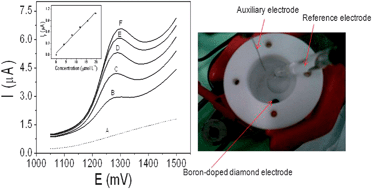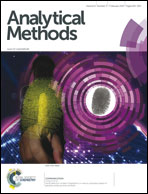The boron-doped diamond electrode voltammetric method for ultra-trace determination of the fungicide pyraclostrobin and evaluation of its photodegradation and thermal degradation
Abstract
The quasi-reversible electrochemical oxidation of pyraclostrobin on a boron-doped diamond (BDD) electrode is reported. Two well defined oxidation peaks (around +1300 to +1650 mV) were observed allowing the development of a square-wave voltammetric method for the ultra-trace determination of pyraclostrobin in natural waters and in grape juice. The anodic scanning was employed (from +1050 to +1500 mV) with a peak maximum at +1280 mV using acetate buffer (0.050 mol L−1; pH 4.0). The linear response (R2 > 0.99) was up to 2.0 × 10−5 mol L−1 (7.8 mg L−1) with a limit of quantification of 8.2 × 10−7 mol L−1 (0.32 mg L−1). Recovery values obtained using analyte fortified water samples were between 94 and 102%. There was no significant thermal degradation of pyraclostrobin in the solution heated at 60 °C for 2 h. The kinetics of degradation of pyraclostrobin (at a concentration of 1.0 × 10−3 mol L−1) upon exposure to UV radiation was also evaluated.


 Please wait while we load your content...
Please wait while we load your content...